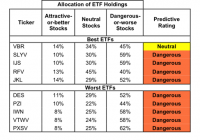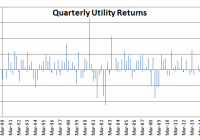How Does VXUP/VXDN’s Corrective Distribution Work?
It’s now clear that the AccuShares Spot CBOE VIX Up Shares ETF (NASDAQ: VXUP )/the AccuShares Spot CBOE VIX Down Class Shares ETF (NASDAQ: VXDN ) naysayers were right – the actual behavior of these funds is nowhere close to Accushares’ claim that ” VXUP and VXDN are the first securities to offer direct “spot” exposure to the CBOE Volatility Index (VIX). ” Accushares has said nothing publicly about the poor behavior of the funds. Their only response has been to move up the “go live” date of their Corrective Distribution process. This is a desperation move. Apparently not understanding what has happened to them they are rushing to use the last weapon at their disposal to fix their horrible tracking error (as high as 18%) relative to the VIX. This move will reduce their tracking problem for less than a day and add yet another complexity to these already complicated and broken funds. Accushares’ Corrective Distribution (CD) is intended to reduce any ongoing differences between VXUP/VXDN’s Net Asset Value (NAV) and its market price. I don’t know what specific scenarios they were targeted with in this process, but I’m guessing they were worried about a slow, progressive creep in the market prices versus the NAV. The CD is triggered if there are 3 consecutive days where the tracking error (difference between NAV and closing price) is 10% or greater. To be a valid closing price the last trade must occur within 30 minutes of market close. When the CD is triggered it doesn’t occur immediately, it’s scheduled to accompany the next monthly Regular Distribution or a Special Distribution if that occurs first. A Special Distribution is triggered by a greater than 75% rise in the VIX compared to the reference VIX value established at the beginning of the monthly cycle. Accushares did not expect frequent CDs to be required; in the prospectus they state: “The Sponsor expects that Corrective Distributions will be infrequent, and may never occur.” It’s likely they will occur on a near monthly basis. When there is a significant gap between the VIX’s value and VIX futures prices (which is most of the time) the VXUP/VXDN tracking error will be large. See this post for a near real time accounting of these errors. With a combined Regular Distribution and Corrective Distribution three things occur: The NAV of the higher valued fund is set to equal the NAV of the lower valued fund. A dividend is issued that compensates the holders of the higher valued fund for the drop in NAV value. The dividend is either in cash or an equal number of VXUP/DN shares with a net value equal to the cash dividend. Accushares issues a new complementary share to every shareholder. If you have VXUP, you will get VXDN shares and vice versa. This is the Corrective Distribution mechanism. Since Accushares can’t create assets out of thin air, they must compensate for the newly doubled number of shares outstanding by dropping their value by half (or do a 2:1 reverse stock split). The effect of the Corrective Distribution is not obvious. Working through an example is a good way to understand it. Imagine that a CD has been triggered and that a Regular Distribution is about to occur. You own 1,000 shares of VXUP. Let’s assume that the market price of VXUP is $27.5, the VXUP NAV is $25, and that the VXDN NAV is $22 at market close right before the distribution. You would receive a dividend of $3/share due to the resetting of VXUP’s $25 NAV value down to VXDN’s ending cycle value of $22. You would also receive 1,000 shares of VXDN. The new NAV value would be $22/2 = $11/share because Accushares doubled the number of shares outstanding. Before the CD the VXUP shares in your account were worth $27.5 X 1,000 = $27.5K. After the Regular/Corrective Distribution your account has: Your net account value drops to $25K – your $2.5K premium over NAV has disappeared. Any premium over the closing NAV value is wiped out by the CD. The next day VXUP will likely trade at a multiple percentage points over NAV, but your VXDN shares will likely be trading at a symmetrical discount from NAV, so the net value of your shares will remain at around $22K. Accushares has essentially cashed out your account at the NAV price – no premium for you… No diligent shareholder will willingly take this sort of loss, nor short seller pass up this opportunity for profit; the market will ensure the value of these funds converges near to NAV the eve of the distribution. From an entertainment value perspective, there will be a couple of things to watch once the CD mechanism becomes effective: Will traders attempt to prevent CDs from happening? Imagine a scenario where some groups are trying to prevent a CD from happening by selling, or short selling shares, while others hoping to profit from a CD are buying shares hoping to keep the tracking error above 10%. How low will the tracking errors go before the CD date? Short sellers would tend to drive the tracking errors to zero, but the about to expire VIX futures values will be decaying rapidly at that point, so significant intra-day profits might still be available to arbitrageurs on the last days of trading. The net effect of the CD will be to complicate and disrupt an already difficult situation. It won’t fix the funds. What Accushares should do is eliminate the Corrective Distribution. Once broken is better than twice broken. Disclosure: None

